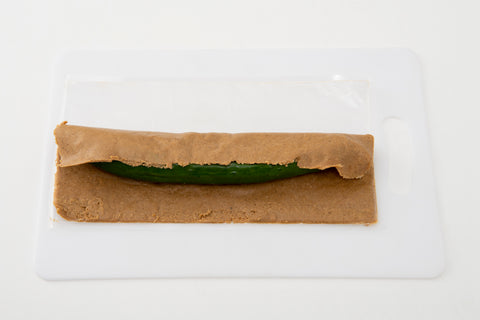RECIPE: Nukazuke Pickled Vegetables

Tsukemono (lit. "pickled things") are served with nearly every Japanese set meal. Crisp and slightly sour, tsukemono are eaten to refresh the palate, lighten heavy meals, cut through fattiness, or add a touch of brightness to any dish.
Although it’s hard to pinpoint exactly when tsukemono first appeared in Japanese cuisine, it is said that nukazuke, foods pickled in fermented rice bran, first emerged during the Edo period.
You can make nukazuke using nuka (rice bran starter) or with our special nukazuke sheets.
Ingredients:
- Raw vegetables (e.g., Asian or Persian-style cucumbers, carrot, daikon, Chinese or Japanese-style eggplant) cut into chunks if using nuka or one whole vegetable left whole if using the nukazuke sheet
- Nuka or nukazuke sheet
Instructions (Nuka):
- Completely cover the vegetable chunks with nuka using your hands (be sure to wash them before and after), and store in the fridge in a sealed container for at least 18 hours, or up to 2-3 days. Slice and serve.

Instructions (Nukazuke Sheet):
- Completely open the nukazuke sheet by cutting the plastic.
- Place the vegetable onto the nukazuke sheet. If the vegetable is too long to fit on the sheet, you can cut it to size but do not slice the vegetable. Leave the vegetable as whole as possible.
- Tightly roll the vegetable so that the sheet of rice bran is in direct contact with the entire surface of the vegetable, without any air pockets. You can use your hands to mold the sheet to ensure a tight fit.
- Wrap the nukazuke roll in plastic wrap and put in the fridge for at least 18 hours, or up to 2-3 days for a deeper flavor.
- Unwrap the vegetable from the nukazuke sheet but save the excess nuka (this can be used to pickle vegetables in the future). Rinse the vegetable to remove any remaining nuka, slice and serve on top of rice or as a side dish.
- Leftover nuka can continue to be used to pickle vegetables (see instructions above) if cared for properly - it’s a living organism! To maintain the nuka, stir it daily to prevent molding, or store it in the fridge for up to two weeks when daily stirring is not possible. Be sure to use it periodically to pickle vegetables. If any liquid comes out, dab with paper towels.







